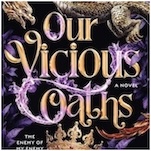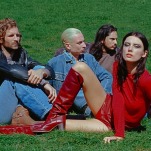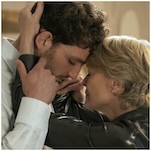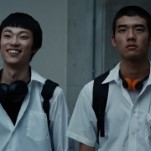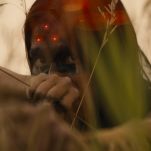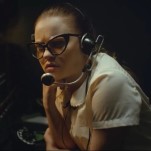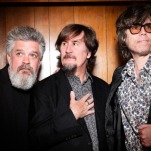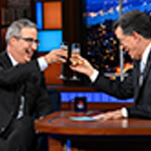The Hitchhiker’s Guide to the Galaxy at 20: Filming the Unfilmable Comedy

The reasons for a property to be considered unadaptable or “unfilmable” are capable of being just as specific, eclectic and difficult to pin down as the rationales behind why any given person loves or hates a specific piece of art, but this is likely particularly true when it comes to the work of author Douglas Adams. The creator of The Hitchhiker’s Guide to the Galaxy was a singular comedic mind, not particularly difficult for other creators to generally imitate in the nearly 25 years since his death, but beyond impossible for anyone to precisely replicate. No one thinks exactly as Douglas Adams did, nor can evoke his precise turns of phrase. It’s the reason why passages from The Hitchhiker’s Guide to the Galaxy, first produced as a 1978 radio serial, and then a 1979 novel, still produce delighted guffaws (or confused head-scratching) in first-time readers–the work of Adams teases the intellect with humor that stands out both for its absurd wit and wry distillation of human foibles.
It’s also why, for several decades, the popular series of Hitchhiker’s Guide novels were considered a potential minefield for big screen adaptation. Wordy, flighty, dense and filled to the brim with constantly changing locales and long-winded asides, but light on conventional narrative, the series reads like an anathema to traditional Hollywood screenplay construction. Adams wrote his most famous works in a style that at times reads like he’s pulling an all-nighter to get an assignment turned in the next morning, but he simultaneously manages to thread in elements of improbable continuity that won’t pay off for another three novels. The push and pull between spontaneity and carefully planned payoffs make The Hitchhiker’s Guide to the Galaxy unique.
These factors, along with the inevitable fandom arguments derived from casting, production and marketing, combined to make for a divisive 2005 film adaptation of the first book in the series that originally hit theaters 20 years ago this week. This film, directed by Garth Jennings from a screenplay originally drafted by Adams himself before his tragic passing at just 49 years of age in 2001, yielded a generously budgeted Hollywood adaptation that was praised for elements of its production design and performances, but simultaneously viewed as a disappointment by many of the (particularly critical and possessive) Hitchhiker’s Guide faithful, who felt it still failed to properly channel the ineffable humor of Adams. Two decades removed, however, we can look back at Jennings’ film and reasonably conclude that although there are elements that feel askew, it reads as a loving tribute to Adams’ “unadaptable” vision, one that likely comes as close to getting the ideas of Hitchhiker’s Guide across as anything reasonably could have at the time. At the very least, it’s funny enough, imaginative enough, to still be a worthy sci-fi comedy on its own merits. And considering the uphill battles the film faced to get made, that’s an achievement in and of itself.
The Long Road Toward The Guide
The idea of turning The Hitchhiker’s Guide to the Galaxy–a story that begins with the destruction of Earth, and a sole Englishman’s introduction to a much wider, sillier cosmos–into a feature film has existed for almost as long as the material itself, and Adams was often involved in frustrating attempts at planning a movie. After a 1981 BBC TV series adaptation, Adams began eyeing a film version, and by 1982 was working with Ivan Reitman on a potential adaptation, with producers suggesting potential parts for the likes of Bill Murray and Dan Aykroyd. Oddly enough, after Aykroyd was brought on board, he reportedly began pitching his own sci-fi screenplay to Reitman, the result becoming a little film you might recall as 1984’s Ghostbusters. Douglas Adams, meanwhile, put thoughts of a Hitchhiker’s Guide film adaptation aside for a time, before eventually crafting a new screenplay version in early 2001, only months before his unexpected death from a heart attack. Austin Powers director Jay Roach was tasked with leading the project, which circled actors like House’s Hugh Laurie to portray Arthur Dent (this would have been great!), and Jim Carrey of all people as Zaphod. The author’s death, however, inevitably stalled production as producers weighed whether a Hitchhiker’s Guide adaptation could really carry on without him.
It was ultimately executive producer (and Adams’ longtime friend) Robbie Stamp who nudged the project forward in the next few years, seeing its unfinished outline as a potential tribute to the author that he couldn’t bear to leave in an unfinished state. Jay Roach moved on from the film and was replaced by the relatively inexperienced Jennings, while writer Karey Kirkpatrick was brought in to complete and revamp elements of Adams’ screenplay, with access to the author’s notes. Some new material was ultimately threaded into the story: Most notably the creation of the character Humma Kavula (John Malkovich), to serve as a secondary antagonist for Zaphod and a narrative pit stop on the way to the fabled planet of Magrathea, the site of “the answer” to the ultimate question of “life, the universe and everything.” The main cast was reshaped to include Martin Freeman (Arthur), Mos Def/Yasiin Bey (Ford Prefect), Sam Rockwell (Zaphod Beeblebrox), Zooey Deschanel (Trillian), Alan Rickman (Marvin the Paranoid Android) and numerous British luminaries in smaller parts, including Bill Nighy, Helen Mirren, Ian McNeice, Richard Griffiths and Stephen Fry–one of Adams’ own top choices–as the voice of the titular Guide.
Of these, it’s the consternated Freeman who feels perhaps most perfectly on the money for Adams’ original story. His Arthur Dent is a provincial man with small ambitions, resisting the call to adventure much as Freeman would again while portraying Bilbo Baggins in Peter Jackson’s Hobbit films years later. He provides exactly the sort of stubborn, pragmatic, grounded sensibility necessary for the more boisterous characters to play against–just a Briton, endlessly questing for a decent cup of tea, the one thing that no longer seems to exist in a reality that no longer contains the Planet Earth. Arthur is amusingly unable to see the forest for the trees, hung up on the details of the hijinks in which the group is always embroiled rather than having a moment to truly take in the mind-blowing implications and possibilities of a galaxy populated from one end to the other by this kind of strangeness. I’d like to think that Adams would have approved of this protagonist.
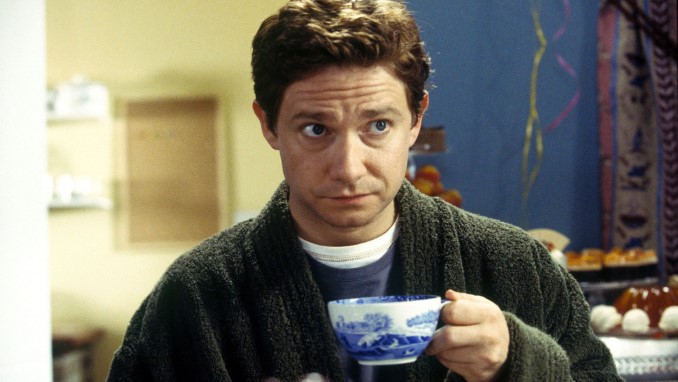
Translating Adams’ Humor for the Screen
The single biggest hurdle in a movie adaptation of The Hitchhiker’s Guide to the Galaxy has to be the fact that so many of the novel’s most side-splitting jokes are simply the kinds of gags that can only properly exist on the written page; jokes that are delivered by and dependent upon an appreciation of the English language and verbal description. Consider one of the more iconic lines, in a vacuum: “The ships hung in the sky much in the same way that bricks don’t.”
In only a few words, it’s the essence of Douglas Adams, distilled. A perfectly absurd comparison, which provokes bewilderment and joy. How does one transport that joke to a visual medium? You can certainly show ships hanging in the sky, but the comparison to bricks not hanging similarly doesn’t exactly evoke itself on its own–someone needs to make that strange observation. You can, to some extent, tell that sort of joke through a narrator–and The Hitchhiker’s Guide to the Galaxy frequently employs one to illustrate the Guide–but that’s also a device you can’t constantly use all film long. The heart of Adams’ novel is often found in long-winded descriptive tangents of this nature, where the author just goes off on a ramble about a particular subject, the book readers effectively signing off on going along for the ride. But it’s only natural for a film producer looking at these kinds of diversions to wonder aloud the obvious question: Just how impenetrable will all of this be to someone who has never read the book?
The solution of Jennings’ film is largely to condense, smooth and simplify the path forward wherever possible, allowing for the occasional humorous aside, typically delivered as narrated readings from the Guide. There’s still room for some pure, wackadoo absurdity, as in the well-liked bit in which Arthur and Ford are briefly transformed into living sofas, but this Hitchhiker’s Guide to the Galaxy makes its appeal as a feature primarily by the fact that it keeps itself largely on task. Minor book antagonists such as the Vogons are likewise given a recurring status to serve as something more akin to overarching villains, which helps the film position them as more recognizably bureaucratic parodies for the mid-2000s audience. As Ford puts it: “They can’t think, they can’t imagine; most of them can’t even spell … they just run things.”
Those Vogons are brought to life by the element that stands out today as perhaps the most notable artistic achievement in this adaptation of Hitchhiker’s Guide, which is the absolutely gorgeous/hideous, full-scale hybrid animatronics/puppets that were designed for the film by The Jim Henson Company. These partially manned suits, bigger than life size, are a genuine marvel, and they give a disgustingly tactile feel to the Vogons that combines bulbous alien weirdness with detestably human characteristics as the film satirizes fat cat career politicians and civil servants. Given the timeframe in which the film was made, one has to consider how easily the Vogons could have ended up as hideous, entirely CGI creations, a choice that would have no doubt noticeably dated the film when returning to it today. Instead, these unique puppet creations feel timeless, and they lend a vitality to the strong production design of Jennings film that remains undiminished in 2025. Much of The Hitchhiker’s Guide to the Galaxy still looks great, in fact, from the deeply unlikely creations of the Infinite Improbability Drive to the charmingly dopey and hunched, “man in a suit” amble of Marvin, which of course benefits greatly from the morose vocal performance of Alan Rickman.
To the Douglas Adams superfans of the mid-2000s, however, few of these elements seemed to garner the film much acclaim. Protective, perhaps, of a nerdy niche that was seeing a moment of wider exposure, many fans railed against the adaptation of The Hitchhiker’s Guide to the Galaxy for its perceived “Americanization” and loss of any inherent Britishness, particularly when it comes to elements such as Sam Rockwell’s portrayal of Zaphod as more of a vapid, George Bush-coded doofus than smug schemer. Even though many of these elements represented Adams’ own concepts for making his story more accessible on a wider, global scale, the hurt feelings were ultimately predictable. The film can be indelicate: At one point it writes in a “point of view gun,” which is an excuse for characters to flatly perceive each other’s emotions and state them out loud for the audience’s benefit. You can feel, at times, the lack of faith that producers must have had in the viewer’s likelihood of processing the jokes. But at the same time, the film’s enthusiasm remains infectious, echoed by the genuine, earnest appreciation a character like Slartifarbast seems to possess for the silly business of engineering a new version of the Earth. The film recognizes that it possesses imperfections, for the sake of addressing a different audience than the novels, and it accepts what it needs to be in order to speak to those new viewers.
It’s little wonder, all the same, that Jennings’ Hitchhiker’s Guide was never followed by any sequels, despite the ending tease that could have led directly into The Restaurant at the End of the Universe. Those who have read the full Hitchhiker’s Guide series know that the sequels only get all the more strange, challenging and frankly less humor-driven as time goes by, taking everything that was already difficult to adapt and only adding further layers of complication. Case in point: Arthur at one point in the third book encounters a creature called Agrajag, who he learns is an insane, homicidal being who has been killed in every reincarnated form he has ever possessed, by Arthur, and he’s now bent on revenge. You’re probably assuming that said creature would be the main antagonist of the book, or an entire book series, but he promptly enters and exits the story in a single scene, while simultaneously setting up a future joke/reference that doesn’t pay off until two entire novels later, in the closing moments of fifth novel Mostly Harmless.
And that’s Douglas Adams for you. Always two steps ahead, and one step behind, contorting the reader until they can’t help but surrender to laughter. The Hitchhiker’s Guide to the Galaxy we received in 2005 is not a perfectly realized, enlivened representation of this kind of humor, but it wouldn’t have been realistic in the first place to expect that of it. What it did well was allowing viewers to dip a toe into a deep ocean of absurdity, judging for themselves whether they wanted to take the plunge into Adams’ gift of the written word. And in that respect, I think it’s fair to call the film at least a modest success, one worth a belated revisit in the great writer’s honor. Just don’t forget your towel.
Jim Vorel is Paste’s Movies editor and resident genre geek. You can follow him on Twitter or on Bluesky for more film writing.
















